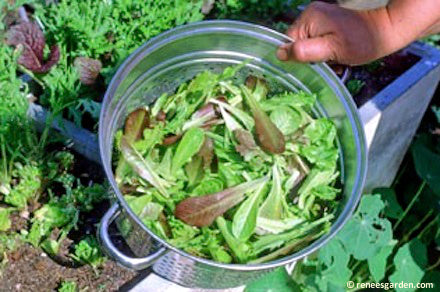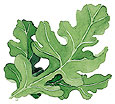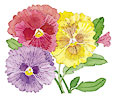
What To Plant If You Don't Have Full Sun
By guest author Alice Formiga
I've found that a garden with some shade is ultimately more satisfying than one with full blasting sunlight. It offers the chance to create a cool retreat in which to sit and enjoy the garden or dine outdoors on hot summer days. It's helpful for extending the harvest season of crops which might otherwise bolt too quickly in summer heat, and you can enjoy all the beautiful ornamental plants that actually prefer some shade to thrive. I was just reminded of the great multitude of shade-loving plants on a hike through an old-growth section of our local forest. Under a canopy of Douglas firs and Western maples was growing a dense carpet of huge, tropical looking ferns, lacy-leaved Meadow Rue, splendid white flowering Dogwood, and delicate pink Bleeding Hearts, among many others. As we stood on a bridge over a stream in a canyon, admiring this incredible diversity and beauty, we thought we were in Paradise!
Still, many gardeners face the following dilemma: They want to grow vegetables and herbs, but don't have the required 6 hours of direct sunlight per day that most edible plants need. Or, they want to grow some colorful flowers from seed, but aren't sure which will grow in their partially shady location. Depending on the type of shade your garden receives, as well as your climate and the time of year, you may be surprised at the range of choices you actually have.
The first step in selecting plants for your garden is knowing how much sun it actually receives at different times of year. Draw a map of your garden and note the position of buildings and trees, and when they are likely to cast shadows. The area in front of my living room window, for example, is shady in summer but sunny in winter. When a large oak loses its foliage-so it's a perfect spot for early spring-flowering bulbs. I located our vegetable garden in the middle of a large field behind our house (although I'd have preferred it closer to the back door) because our house casts long shadows to the East in late summer and fall. After you've drawn up a plan, it's helpful to understand some of the different kinds of shade, and which plants tolerate each.
Types of Shade
Partial or Half Shade: This very variable and confusing term is often defined as about half a day of direct sun. Gardeners in areas with 5-6 hours of afternoon sun may be able to grow most vegetables and herbs. However, those with only 3-4 hours of morning sun will have better success with true shade-lovers, and should choose other types of plants as the main focus of their gardens.
Dappled Shade, or Light Shade: The sunlight in these areas is filtered through trees with an open habit and small leaves, rather than a dense leaf cover. Sun falls on your garden, but it doesn't hit specific sections for as long as it would without the trees. Again, the longer and brighter the sun shines in a particular area, the more flexibility you have in your choice of edibles and shade-tolerant annuals for that spot.
Open Shade: An example of this would be the North side of a building which gets no direct sun throughout the entire day, but is not otherwise covered by trees or structures. In general, this is too much shade for good production of most vegetables.
Full Shade, or Dense Shade: In this situation the garden doesn't receive direct sun and is also shaded by trees or structures, resulting in little ambient light. The plants in this article are unlikely to thrive in such a location.
Vegetables and Herbs for Half Shade and Dappled Shade

If you are unsure whether you have enough sunlight for these crops to grow well, start small and experiment. If you have too much shade, leaves will be spindly, soft and weak. They'll have a mild, bland flavor and lack crispness.
Flowers for Half Shade and Dappled Shade

A variety of cutting flowers, such as our "Chantilly" snapdragons, "White Wonder" feverfew, "Marble Arch" salvia , and "Pride of Gibraltar" cerinthe can also tolerate about half a day of shade. For containers, I like ruffled "Victorian Posy" pansies.
Flowers for Open Shade

Tips for Growing Plants from Seed in Partial Shade
Keep your soil moist but not soggy to avoid damping off of seedlings, particularly if the weather is cool. Since water doesn't evaporate as quickly as it does in full sunlight, you may not need to water as often. Make sure to follow the packet directions and don't plant too early in the season!
Plant in well-drained soil. Dig soil at least a foot deep and add about a six inch layer of well-rotted sifted compost before sowing your seeds. Most plants are unlikely to thrive if planted directly under large trees unless the soil is dug in pockets between tree roots and covered with a thick layer of well-rotted compost.
Protect young seedlings from slugs and snails who inhabit shady places, and hide under mulch or in nearby grass. I prefer to use a granular bait made out of chelated iron called "Sluggo" because it is safer to use around pets than liquid baits.
When you thin or transplant your plants to their final spacing, plant them no closer than recommended on the seed packet, or slightly farther apart to allow some air to circulate around the plants.
If you are growing seedlings in flats, choose a location with as much light as possible for strong plants better able to withstand transplanting. Partial shade is a good place to harden off seedlings grown in a greenhouse or under grow lights indoors as they can more gradually adjust to outdoor growing conditions and don't evaporate moisture as quickly as they would in full sun.
To purchase Renee's Garden Seeds click here.
Still, many gardeners face the following dilemma: They want to grow vegetables and herbs, but don't have the required 6 hours of direct sunlight per day that most edible plants need. Or, they want to grow some colorful flowers from seed, but aren't sure which will grow in their partially shady location. Depending on the type of shade your garden receives, as well as your climate and the time of year, you may be surprised at the range of choices you actually have.
The first step in selecting plants for your garden is knowing how much sun it actually receives at different times of year. Draw a map of your garden and note the position of buildings and trees, and when they are likely to cast shadows. The area in front of my living room window, for example, is shady in summer but sunny in winter. When a large oak loses its foliage-so it's a perfect spot for early spring-flowering bulbs. I located our vegetable garden in the middle of a large field behind our house (although I'd have preferred it closer to the back door) because our house casts long shadows to the East in late summer and fall. After you've drawn up a plan, it's helpful to understand some of the different kinds of shade, and which plants tolerate each.
Types of Shade
Partial or Half Shade: This very variable and confusing term is often defined as about half a day of direct sun. Gardeners in areas with 5-6 hours of afternoon sun may be able to grow most vegetables and herbs. However, those with only 3-4 hours of morning sun will have better success with true shade-lovers, and should choose other types of plants as the main focus of their gardens.
Dappled Shade, or Light Shade: The sunlight in these areas is filtered through trees with an open habit and small leaves, rather than a dense leaf cover. Sun falls on your garden, but it doesn't hit specific sections for as long as it would without the trees. Again, the longer and brighter the sun shines in a particular area, the more flexibility you have in your choice of edibles and shade-tolerant annuals for that spot.
Open Shade: An example of this would be the North side of a building which gets no direct sun throughout the entire day, but is not otherwise covered by trees or structures. In general, this is too much shade for good production of most vegetables.
Full Shade, or Dense Shade: In this situation the garden doesn't receive direct sun and is also shaded by trees or structures, resulting in little ambient light. The plants in this article are unlikely to thrive in such a location.
Vegetables and Herbs for Half Shade and Dappled Shade

If you are unsure whether you have enough sunlight for these crops to grow well, start small and experiment. If you have too much shade, leaves will be spindly, soft and weak. They'll have a mild, bland flavor and lack crispness.
Flowers for Half Shade and Dappled Shade

A variety of cutting flowers, such as our "Chantilly" snapdragons, "White Wonder" feverfew, "Marble Arch" salvia , and "Pride of Gibraltar" cerinthe can also tolerate about half a day of shade. For containers, I like ruffled "Victorian Posy" pansies.
Flowers for Open Shade

Tips for Growing Plants from Seed in Partial Shade
Keep your soil moist but not soggy to avoid damping off of seedlings, particularly if the weather is cool. Since water doesn't evaporate as quickly as it does in full sunlight, you may not need to water as often. Make sure to follow the packet directions and don't plant too early in the season!
Plant in well-drained soil. Dig soil at least a foot deep and add about a six inch layer of well-rotted sifted compost before sowing your seeds. Most plants are unlikely to thrive if planted directly under large trees unless the soil is dug in pockets between tree roots and covered with a thick layer of well-rotted compost.
Protect young seedlings from slugs and snails who inhabit shady places, and hide under mulch or in nearby grass. I prefer to use a granular bait made out of chelated iron called "Sluggo" because it is safer to use around pets than liquid baits.
When you thin or transplant your plants to their final spacing, plant them no closer than recommended on the seed packet, or slightly farther apart to allow some air to circulate around the plants.
If you are growing seedlings in flats, choose a location with as much light as possible for strong plants better able to withstand transplanting. Partial shade is a good place to harden off seedlings grown in a greenhouse or under grow lights indoors as they can more gradually adjust to outdoor growing conditions and don't evaporate moisture as quickly as they would in full sun.
To purchase Renee's Garden Seeds click here.



